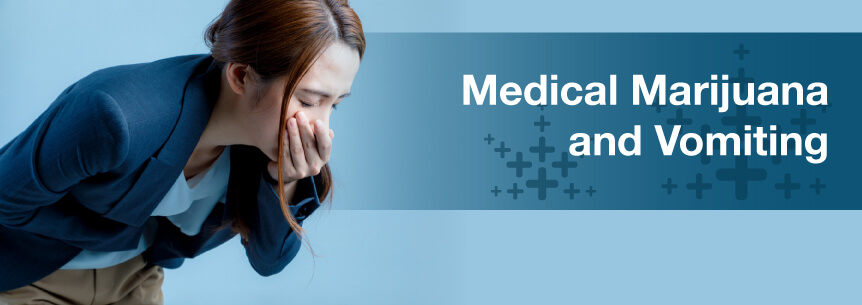
Nobody likes to vomit. While rarely painful, vomiting is — let’s face it — very unpleasant. Not only is the thought of revisiting your stomach contents disgusting enough, but you also have the other horrible symptoms with it, like abdominal pain, fever, diarrhea and more.
The good news is you don’t have to suffer through it, and chances are you may even be able to prevent it the minute you feel nauseated just by consuming a little cannabis. Learn why so many people are turning to medical marijuana and vomiting treatment for immediate relief.
Cannabinoids activate the endocannabinoid system (ECS) receptor sites which help suppress vomiting, making medical cannabis for vomiting a great anti-nausea drug choice. The ECS is made up of receptor sites existing on cells throughout your body. After you ingest cannabinoids like CBD and THC, they begin activating these sites, causing extensive biological changes.
Find A Doctor Find A Dispensary

Cannabinoids in cannabis and vomiting treatment are very similar to your body’s natural endocannabinoid compounds, which are why cannabinoids influence the ECS system so well. These endocannabinoids play significant roles in different functions like ameliorating inflammation and regulating mood.
The British Journal of Pharmacology published a scientific paper showing evidence that suggests manipulating the ECS system can regulate vomiting. Researchers say you gain the anti-nausea and anti-emetic effects of cannabinoids by activating the ECS receptor sites.
The THC, in particular, in marijuana and vomiting treatment is an antiemetic, meaning it’s a treatment for relieving vomiting and nausea. During a study in 2001, researchers gave healthy volunteers THC along with ipecac syrup, which induces vomiting. The THC in cannabis reduced the volunteers’ feelings of “queasiness” and their vomiting significantly. Other OTC antiemetic medications are available to settle your stomach, but aren’t as effective.
Currently, severe nausea, intractable nausea or chemotherapy-induced nausea is a qualifying condition in many legal states.
Cannabinoids have successfully treated chemotherapy-induced nausea and vomiting (CINV) symptoms for some time now. Doctors administer two synthetic cannabinoids orally: dronabinol and nabilone. The Food and Drug Administration approved nabilone and dronabinol in 1985 for treating CINV.
A small number of heavy cannabis users worldwide are developing a rare condition called cannabinoid hyperemesis syndrome that causes abdominal pain and vomiting. Experts aren’t clear on the cause. The condition is extremely rare in users when you compare it to the general number of cannabis users.
Along with pain and inflammation, nausea is among the three main symptoms medical marijuana treats effectively. Patients with cancer receiving radiation or chemotherapy were among the first groups to realize how powerful medical weed is. Ingesting the herb enables cancer patients to eat their food and keep it down, which helps combat muscle wasting and weight loss.
Other symptoms marijuana and vomiting treatment can tackle include:
Whether your vomiting is a symptom of an underlying condition or a side effect of this condition’s treatment, weed can help. Here are a few strains you can try or talk to your medical marijuana doctor or budtender about:
Nausea and Vomiting
Pain
Anxiety
When it comes to administering medical pot, users have numerous choices. There really isn’t any “best” form of method or consumption, since each patient is different and each method provides its own effect. The oldest practice is smoking. Vaporizers have now replaced rolled-up marijuana cigarettes or packed bowls for many users who choose this form of medical cannabis delivery.
The onset time, duration and effect will differ slightly with each method of delivery. You may combine many of these to obtain sustained, synergistic relief. The right delivery method for you will depend on your desired intensity, duration, effect and personal preference.
Some of your marijuana and vomiting treatment delivery method choices include:
More pop up all the time, and no doubt there will be more methods of administration to come.
Obtaining your cannabis and vomiting treatment is as simple as visiting MarijuanaDoctors.com. Our site offers a great deal of information on medical marijuana so you can really educate yourself on the benefits of medical marijuana and the process of obtaining it. Take some time to do some research on our site to familiarize yourself.
You can search for a cannabis-friendly doctor on our site and book an appointment with one of our qualified weed doctors. You can also search our huge list of dispensaries if you’re already qualified and ready to shop for your medical cannabis products.
Find A Doctor Find A Dispensary
Vomiting is the involuntary or voluntary forcible emptying of the contents of your stomach through your mouth — sometimes your nose. It has many names, including heaving, retching, puking, upchucking, hurling and throwing up. Its scientific name is “emesis.”
Nausea isn’t the same thing as vomiting, although the two tend to go together. Nausea is an unsettled or uneasy feeling in your stomach you get right before you’re about to vomit. Sometimes it ends with the urge, other times it ends with you vomiting. Neither of these two, however, are diseases in themselves — they’re symptoms of various conditions like:
Causes of vomiting tend to be different depending on age. For kids, vomiting often occurs from a milk allergy, viral infection, overeating, motion sickness or a high fever.
Other common causes of vomiting may include:
The timing of vomiting can signify its cause. For instance, if you vomit shortly after you’ve eaten a meal, it could indicate stomach lining inflammation, food poisoning, bulimia or an ulcer. If you vomit one to eight hours after you eat, it can still mean food poisoning. However, certain food-borne bacteria, like salmonella, can take longer before they cause vomiting.
Both nausea and vomiting aren’t typically serious and are common. Usually, there’s no need for alarm if you start to vomit. However, seek medical attention right away if you suspect poisoning or if you experience any of the following:
There are several types of vomiting, including the following.
Vomiting can occur in both adults and children. Those undergoing medical treatments for cancer, like chemotherapy or radiation therapy, have a higher risk of vomiting.

Women who are pregnant and in their first trimester also have an increased likelihood of vomiting. Though it can happen any time of day, the condition is called “morning sickness,” and estimates suggest around 25 to 55 percent of pregnant women experience vomiting.
Like today, during the 19th century, vomiting and nausea were common symptoms and signs of illness, the explanation of which physicians contributed to their therapeutic, diagnostic and prognostic choices. Aside from being symptoms of some bodily condition, vomiting made up a person’s generally non-medicalized experience of illness.
Throughout the 19th century, vomiting and nausea physiological descriptions followed a typically reductionist avenue. Marshall Hall’s theory of reflex in the 1830s inspired new awareness of the nervous components involved in vomiting and helped prompt their redefinition into central, peripheral and local causes. Changing physiological vomiting and nausea descriptions were additionally contemporaneous to microscopy growth.
Vomiting usually occurs in individuals with infections ranging from gastroenteritis to influenza. Nausea and vomiting symptoms you may experience include:
Although nausea is agitation in your stomach and does often induce the urge to vomit, it doesn’t necessarily lead to it. Some triggers, like food irritation, infection and injury, leading to vomiting often come from your intestines and stomach. They also can come from your brain through tumors, head injury, migraines and brain infections, or your inner ear through motion sickness and dizziness.
Most cases of vomiting go away on their own unless there’s an underlying chronic disorder causing it. Chronic vomiting can lead to malnutrition and dehydration. It can also make your nails and hair brittle and weak and cause tooth enamel decay.
No one enjoys vomiting. Most everyone thinks it’s disgusting, and just watching someone vomiting can be nauseating in itself.
The majority of people aren’t terrified of vomiting, but some people are. If you’re struggling with a form of phobia of vomiting — referred to as emetophobia — the idea of vomiting not only repulses, but terrifies, you. A lot of individuals even say anticipating the act of vomiting is often worse than actually doing it. And, since you’re not sure when it will occur, you’re continually guarding yourself against it and trying to rearrange your life to avoid it.
Anxiety can be a big trigger of nausea and vomiting. And it’s unpredictable — coming and going frequently, rarely or persisting indefinitely. For instance, you may vomit now and then, feel nausea off and on or feel like you’re going to vomit all the time. Vomiting due to anxiety can come before, accompany or follow an intensification of other symptoms and sensations of anxiety. It can also occur by itself.

When you behave anxiously, it activates your stress response, immediately causing certain psychological, physiological and emotional body changes to heighten your body’s ability of dealing with a threat by either fighting with or fleeing from it. The term “fight or flight” describes this stress response.
Suppressing digestion is a part of these stress response changes, so most of the resources in your body are ready for emergency action. When you’re not experiencing this stress response very often, your body can recover fairly easily and quickly from the psychological, physiological and emotional changes incurred by the stress response.
If the stress response occurs too dramatically or frequently, however, it’s more difficult for your body to recover, resulting in your body staying in a state of semi-emergency readiness. This state can adversely affect your digestive system and normal stomach function, causing all types of digestive and stomach-related maladies like vomiting.
You can take several approaches to relieve vomiting, including medications and home remedies.
Relieve nausea and vomiting at home by:
Your doctor will likely ask you some questions regarding your vomiting before they prescribe you any medication, such as when it started and when it’s worst. They’ll also inquire about your eating habits and if any particular foods make you vomit or make your vomiting worse or better. Your doctor may prescribe you Zofran (Ondansetron) to ease your nausea.
You can also purchase over-the-counter medications, especially antiemetics, without a doctor’s prescription to help.
These are anti-nausea medications. They help alleviate your vomiting. While there are numerous antiemetic medications, a couple of common classes of them include the following.

Bismuth subsalicylate: Brand names of these include Pepto-Bismol and Kaopectate. These help treat some forms of vomiting like vomiting due to the stomach flu. Side effects may include:
Antihistamines: Certain antihistamines can also help prevent vomiting caused by motion sickness. A couple of examples are meclizine hydrochloride and dimenhydrinate. Side effects may include:
Bismuth subsalicylate protects your stomach lining, while antihistamines work by dulling your inner ear’s ability of sensing motion. Antihistamines also block the brain messages that control vomiting, making them more effective when you take them before feeling motion sickness.
You can prevent vomiting when you feel nauseated by:
You can prevent vomiting in kids by: